
Choosing a Ligularia
Discover this beautiful opulent perennial.
Contents
The Ligularia or Ligularia is a perennial with exuberant foliage and very bright yellow flowering, thriving in shaded and cool conditions. It is robust, and its beautiful silhouette enhances a spot in the garden that is partially shaded or in full shade with cool to moist, even heavy, soil. It tolerates non-burning sunlight as long as the soil remains cool. If the shade is too dense, it flowers less and its foliage loses its colour. Provided you choose its location well, it is easy to grow. Deciduous, it flowers in summer and late in the season, until September and October. Its ample foliage gives it an exotic appearance, and it is equally at home in natural or contemporary settings.
However, the different species and varieties of Ligularia have quite distinct appearances that are interesting to explore. Discover the charm of the beautiful Ligularias with giant-like foliage, and all our tips for choosing the ideal variety!
Choose according to the shape of the flowers
Make no mistake, Ligularias shine with the quality and opulence of their foliage from spring to late autumn. However, let us first focus on the shape of the flowers, which in their case give a different character to the habit and architecture of the plant. Ligularias bear golden-yellow to orange flowers in summer, depending on the species. These flowers can take two very different forms. In some species, they resemble daisies, in flattened corymbs, close to the foliage and compact, as seen in Ligularia dentata. They can also appear in long, upright clusters of multiple small flowers, offering a vapour-like and graphic aspect, as seen in Ligularia stenocephala or Ligularia przewalskii.
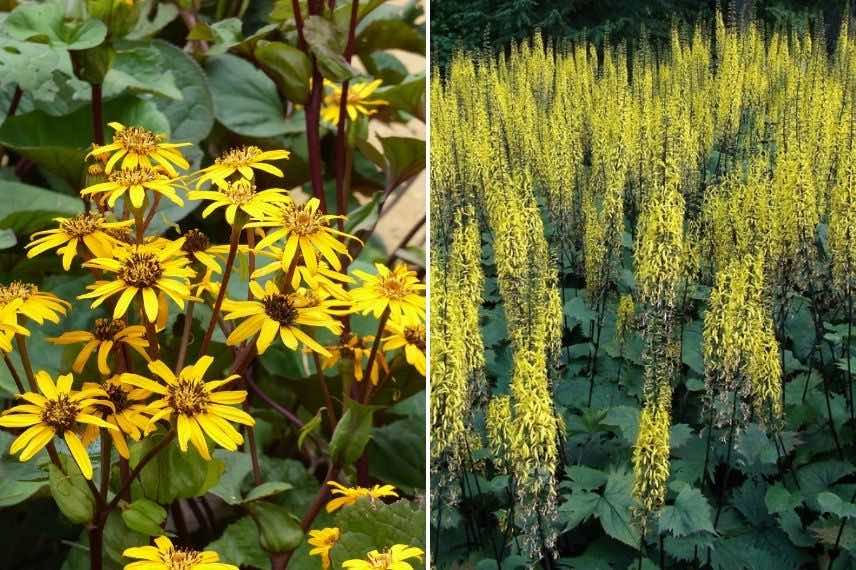
The flowers of Ligularias: on the left, Ligularia dentata ‘Britt-Marie Crawford’ and on the right, Ligularia stenocephala
Choose by height
Ligularias come in various sizes depending on the species, making them suitable for a range of uses and settings. Let’s classify them into three size types:
- Varieties measuring 40 to 50 cm, dwarf. Within this category, there are two particularly small cultivars: Ligularia dentata ‘Pandora’ and Ligularia ‘Osiris Café Noir’, lovely miniatures that you can easily place in borders.
- Varieties from 60/70 cm to 1 m such as Ligularia przewalskii or Ligularia dentata ‘Desdemona’. You can pair them with other perennials that thrive in cool, moist soil to create beautiful lush scenes.
- Species or varieties from 1.5 m to 2 m require more space, their spread increasing with height to reach 1 m or more. Here, we mention the largest: Ligularia wilsoniana or Ligularia ‘Gregynog Gold’, voluptuous giant perennials for exotic scenes. The previously mentioned Ligularia stenocephala and the well-known cultivar ‘The Rocket’ also make for beautiful and large specimens.
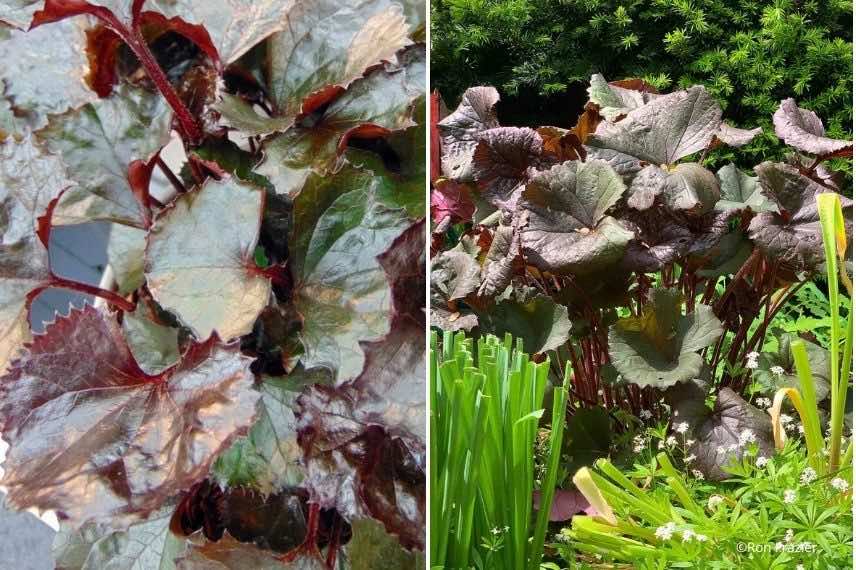
From miniature potted plants to giants at the back of the border
Discover other Ligularia
View all →Available in 1 sizes
Available in 2 sizes
Available in 1 sizes
Available in 1 sizes
Available in 1 sizes
Available in 2 sizes
Available in 1 sizes
Available in 1 sizes
Available in 1 sizes
Available in 1 sizes
Choose based on the shape, appearance, and colour of the foliage.
The foliage of Ligularia is therefore, as mentioned earlier, exceptional in several ways. Its leaves are large, up to 35 cm long, and range from very rounded to very lobed shapes depending on the species. The colours vary from medium to dark green, copper, to chocolate, bronze, purple or black. The leaves are shiny, glossy or matte. The underside of the leaves on species with round leaves is sometimes a different colour from the upper side. The foliage also expresses several aspects: the leaves can be soft and drooping or thick and leathery. Let’s explore some species or varieties to admire the foliage.
Just as we observe two types of flowering, there are essentially two forms of leaves and many nuances thereafter: the round and cordate foliage (heart-shaped), characteristic of Ligularia dentata, and the highly lobed foliage, typical of Ligularia przewalskii.
- The Ligularia dentata features large glossy leaves, 15 to 30 cm long, rounded and toothed, leathery, and deeply veined. In Ligularia dentata, their colours range from dark green to bronze. Some cultivars include: Ligularia dentata ‘Dark Beauty’, which offers leaves of copper-green to dark brown, with a brown-purple underside. Thick and shiny, they resemble leather. In Ligularia dentata ‘Britt-Marie Crawford’, the upper side of the leaves is purple-black with very dark green reflections, and the underside ranges from burgundy to mahogany. The darker the leaves, the more striking the contrast with the flowering.
- The Ligularia przewalskii has deeply lobed leaves, appearing less imposing than the large full leaves of Ligularia dentata, even though their size is also considerable. They are green and remain so.
- Another species has beautifully sculpted leaves (and a unique flowering): the Ligularia tangutica. This is a tall variety, reaching 2.5 m at maturity, with particularly large leaves.
- The Ligularia stenocephala bears large triangular or cordate and strongly toothed green leaves, which can reach 35 cm long and 30 cm wide. It is a large and beautiful Ligularia with character.
- The Ligularia ‘Osiris Fantaisie’ stands out with its curiously undulating and toothed, leathery, shiny leaves, which are purple in spring, then almond green and darker green in summer.
It is worth noting that on some Ligularias, the flower-bearing stems are sometimes very dark, almost black, enhancing their graphic appearance.
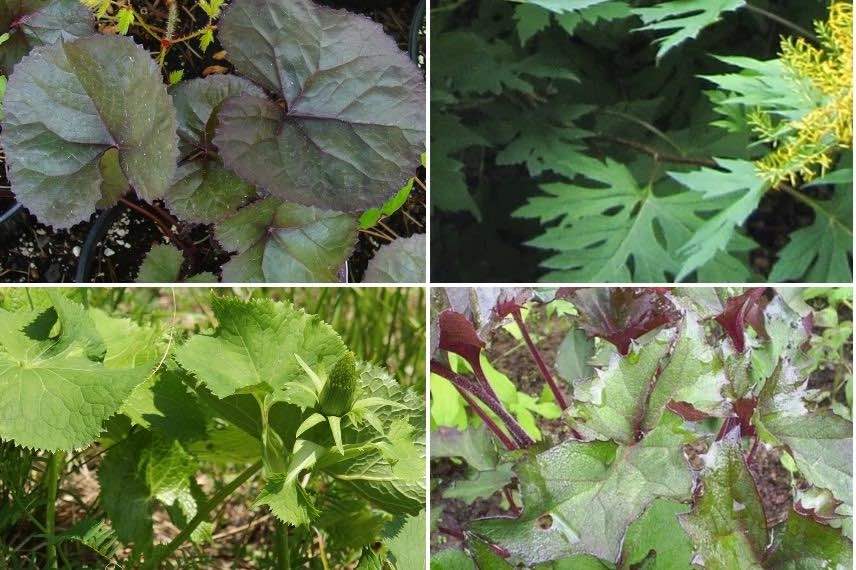
Above: Ligularia dentata ‘Britt-Marie Crawford’ and Ligularia tangutica; below: Ligularia stenocephala and Ligularia ‘Osiris Fantaisie’
Read also
12 perennials for heavy, wet soilChoose according to use
We have seen that Ligularias can measure from 40 cm to 2 m in height depending on the species and cultivars, and they exhibit various shapes and appearances. We have discussed some possible uses; here are a few more:
Plant the smaller cultivars like ‘Pandora’ in pots, in partial shade or in a bright northern position, provided the substrate remains cool to moist. It is a companion for hostas or certain carex in moist soil.
The larger and more imposing Ligularias make beautiful specimens to plant alone, such as the cultivar Ligularia stenocephala ‘The Rocket’.
Ligularias are perfect plants for the edges of banks, to be used alone or mixed with other perennials that thrive in similar conditions, such as Solidagos, Lysimachias, or Persicarias. The Ligularia przewalskii with its finely cut foliage adds a touch of lightness in this setting.
Finally, use them in cool undergrowth alongside ferns, Brunneras, and Digitalis. In this case, choose cultivars from Ligularia dentata such as ‘Britt-Marie Crawford’ to create contrasts with its dark foliage.
Choose according to the flowering period
Although there is no significant difference between Ligularias, which primarily flower between July and September, it is worth mentioning that the Ligularia przewalskii and Ligularia stenocephala species flower early from June.
In contrast, the species and varieties Ligularia hessei, Ligularia ‘Gregynog Gold’ and Ligularia dentata flower late until October. Special mention goes to Ligularia palmatiloba, which can even flower until November. This can be a deciding factor if you choose to create a summer or autumn border.
Choose a protected species
To conclude, let’s mention the Siberian Ligularia or Ligularia sibirica, a protected species in France, found in montane climate in the peaty marshes of the Massif Central and the Pyrénées-Orientales. On a clump of large, heart-shaped, bright green, slightly dentate leaves, it bears upright inflorescences with numerous fairly large yellow clusters in a characteristic terminal arrangement. It reaches a height of 1.5 m and flowers in July and August.

The Siberian Ligularia
- Subscribe!
- Contents
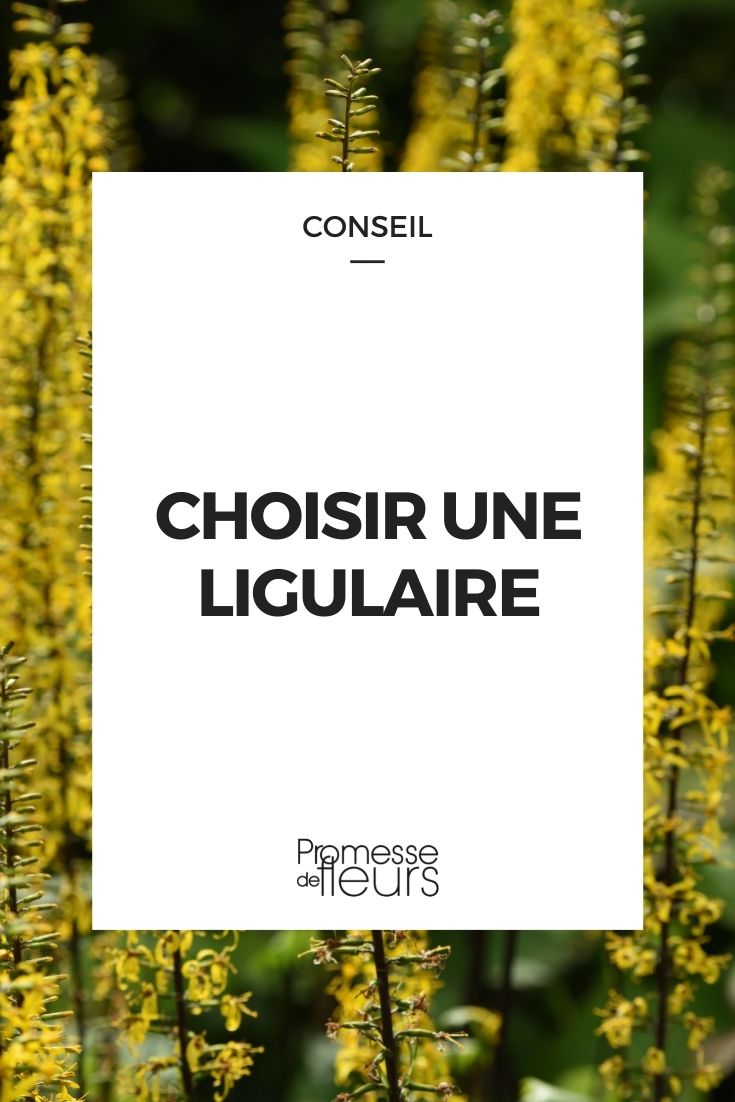
































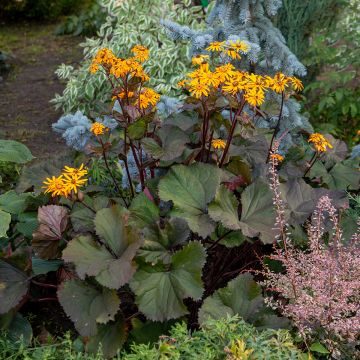

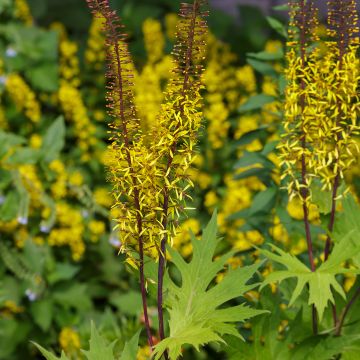

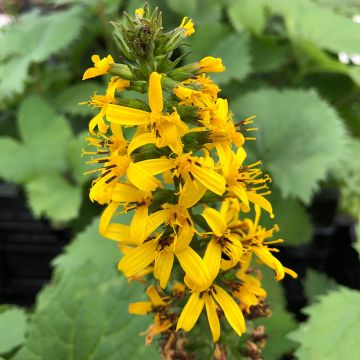
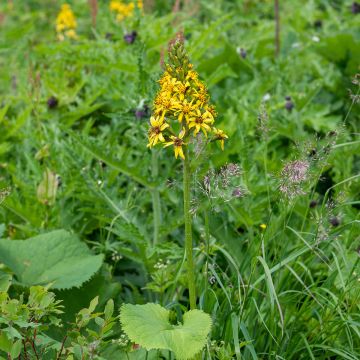



Comments